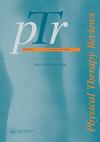中风患者在地上行走时膝麻痹的生物力学:系统综述
IF 0.8
Q4 REHABILITATION
引用次数: 2
摘要
摘要背景步态中偏瘫膝关节的生物力学有很好的记录,但这些数据尚未得到系统的总结和分析。目的分析卒中后偏瘫膝关节在地上步态中与非偏瘫或对照组膝关节的三维光学生物力学数据。方法完成数据库搜索,考虑观察性研究和随机对照试验的基线数据。两名评审员独立筛选研究,提取数据,并使用Downs和Black质量指数确定偏倚风险。进行了定量和描述性分析,并考虑了证据水平。结果纳入了31项研究,其中719名参与者患有中风,274名为对照组。汇集的数据是异构的。描述性分析表明:与非偏瘫膝关节相比,瘫痪膝关节的峰值屈曲减少;与对照膝关节相比,在偏瘫膝关节处摆动期间膝关节屈曲减少;与非偏瘫和对照膝相比,偏瘫膝的矢状运动范围减小;与非瘫痪性膝盖相比,瘫痪性膝盖的峰值(内部)伸展力矩减少。大多数研究都有很高的偏倚风险,表明在目前的证据基础上,证据质量有限。结论与非偏瘫和/或对照膝相比,偏瘫膝关节的峰值屈曲、摆动时的屈曲、活动范围和伸膝力矩降低。相当大的异质性阻碍了荟萃分析。目前的证据基础反映了有限的质量,需要进一步的研究来更好地探索中风后步态模式中出现的生物力学差异。本文章由计算机程序翻译,如有差异,请以英文原文为准。
Biomechanics of the paretic knee during overground gait in people with stroke: a systematic review
Abstract Background Biomechanics of the paretic knee during gait are well documented, yet these data have yet to be systematically summarised and analysed. Objective To analyse three-dimensional optic-based biomechanical data of the paretic knee post-stroke, compared to non-paretic or control participants’ knees, during overground gait. Methods Database searches were completed, with observational studies and baseline data from randomised controlled trials considered. Two reviewers independently screened studies, extracted data, and determined risk of bias using the Downs and Black Quality Index. Quantitative and descriptive analyses were undertaken, with level of evidence considered. Results 31 studies were included, with 719 participants with stroke and 274 controls. Pooled data were heterogenous. Descriptive analyses demonstrated: reduced peak knee flexion at the paretic knee compared to non-paretic knee; reduced knee flexion during swing at the paretic knee compared to control knee; reduced sagittal range of motion at the paretic knee compared to non-paretic, and control knee; and reduced peak (internal) extension moments at the paretic knee compared to non-paretic knee. Most studies were at high risk of bias, demonstrating limited quality evidence in the current evidence base. Conclusion The paretic knee demonstrated reduced peak knee flexion, knee flexion during swing, range of motion, and knee extension moments compared to the non-paretic and/or control knee. Considerable heterogeneity prevented meta-analyses. The current evidence base reflects limited quality, with further research required to better explore biomechanical differences occurring in well documented post-stroke gait patterns.
求助全文
通过发布文献求助,成功后即可免费获取论文全文。
去求助
来源期刊

Physical Therapy Reviews
REHABILITATION-
CiteScore
1.30
自引率
0.00%
发文量
26
期刊介绍:
Physical Therapy Reviews is an international journal which aims to publish contemporary reviews, discussion papers and editorials within physical therapy, and in those basic and clinical sciences which are the basis of physical therapy. The journal is aimed at all those involved in research, teaching and practice within the area of physical therapy. Reviews (both descriptive and systematic) are invited in the following areas, which reflect the breadth and diversity of practice within physical therapy: •neurological rehabilitation •movement and exercise •orthopaedics and rheumatology •manual therapy and massage •sports medicine •measurement •chest physiotherapy •electrotherapeutics •obstetrics and gynaecology •complementary therapies •professional issues •musculoskeletal rehabilitation
 求助内容:
求助内容: 应助结果提醒方式:
应助结果提醒方式:


